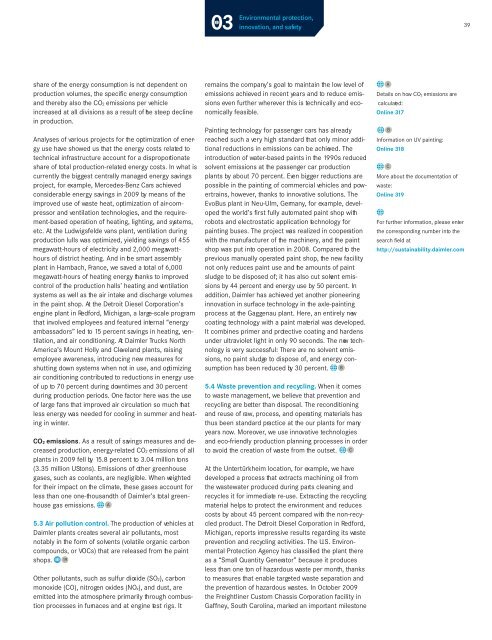Daimler Sustainability Report 2010 - Daimler Sustainability Report ...
Daimler Sustainability Report 2010 - Daimler Sustainability Report ...
Daimler Sustainability Report 2010 - Daimler Sustainability Report ...
Create successful ePaper yourself
Turn your PDF publications into a flip-book with our unique Google optimized e-Paper software.
share of the energy consumption is not dependent on<br />
production volumes, the specific energy consumption<br />
and thereby also the CO2 emissions per vehicle<br />
increased at all divisions as a result of the steep decline<br />
in production.<br />
Analyses of various projects for the optimization of energy<br />
use have showed us that the energy costs related to<br />
technical infrastructure account for a disproportionate<br />
share of total production-related energy costs. In what is<br />
currently the biggest centrally managed energy savings<br />
project, for example, Mercedes-Benz Cars achieved<br />
considerable energy savings in 2009 by means of the<br />
improved use of waste heat, optimization of air-compressor<br />
and ventilation technologies, and the requirement-based<br />
operation of heating, lighting, and systems,<br />
etc. At the Ludwigsfelde vans plant, ventilation during<br />
production lulls was optimized, yielding savings of 455<br />
megawatt-hours of electricity and 2,000 megawatthours<br />
of district heating. And in the smart assembly<br />
plant in Hambach, France, we saved a total of 6,000<br />
megawatt-hours of heating energy thanks to improved<br />
control of the production halls’ heating and ventilation<br />
systems as well as the air intake and discharge volumes<br />
in the paint shop. At the Detroit Diesel Corporation’s<br />
engine plant in Redford, Michigan, a large-scale program<br />
that involved employees and featured internal “energy<br />
ambassadors” led to 15 percent savings in heating, ventilation,<br />
and air conditioning. At <strong>Daimler</strong> Trucks North<br />
America’s Mount Holly and Cleveland plants, raising<br />
employee awareness, introducing new measures for<br />
shutting down systems when not in use, and optimizing<br />
air conditioning contributed to reductions in energy use<br />
of up to 70 percent during downtimes and 30 percent<br />
during production periods. One factor here was the use<br />
of large fans that improved air circulation so much that<br />
less energy was needed for cooling in summer and heating<br />
in winter.<br />
CO2 emissions. As a result of savings measures and decreased<br />
production, energy-related CO2 emissions of all<br />
plants in 2009 fell by 15.8 percent to 3.04 million tons<br />
(3.35 million UStons). Emissions of other greenhouse<br />
gases, such as coolants, are negligible. When weighted<br />
for their impact on the climate, these gases account for<br />
less than one one-thousandth of <strong>Daimler</strong>’s total greenhouse<br />
gas emissions. q A<br />
5.3 Air pollution control. The production of vehicles at<br />
<strong>Daimler</strong> plants creates several air pollutants, most<br />
notably in the form of solvents (volatile organic carbon<br />
compounds, or VOCs) that are released from the paint<br />
shops. �<br />
19<br />
Other pollutants, such as sulfur dioxide (SO2), carbon<br />
monoxide (CO), nitrogen oxides (NOx), and dust, are<br />
emitted into the atmosphere primarily through combustion<br />
processes in furnaces and at engine test rigs. It<br />
Environmental protection,<br />
innovation, and safety<br />
remains the company’s goal to maintain the low level of<br />
emissions achieved in recent years and to reduce emissions<br />
even further wherever this is technically and economically<br />
feasible.<br />
Painting technology for passenger cars has already<br />
reached such a very high standard that only minor additional<br />
reductions in emissions can be achieved. The<br />
introduction of water-based paints in the 1990s reduced<br />
solvent emissions at the passenger car production<br />
plants by about 70 percent. Even bigger reductions are<br />
possible in the painting of commercial vehicles and powertrains,<br />
however, thanks to innovative solutions. The<br />
EvoBus plant in Neu-Ulm, Germany, for example, developed<br />
the world’s first fully automated paint shop with<br />
robots and electrostatic application technology for<br />
painting buses. The project was realized in cooperation<br />
with the manufacturer of the machinery, and the paint<br />
shop was put into operation in 2008. Compared to the<br />
previous manually operated paint shop, the new facility<br />
not only reduces paint use and the amounts of paint<br />
sludge to be disposed of; it has also cut solvent emissions<br />
by 44 percent and energy use by 50 percent. In<br />
addition, <strong>Daimler</strong> has achieved yet another pioneering<br />
innovation in surface technology in the axle-painting<br />
process at the Gaggenau plant. Here, an entirely new<br />
coating technology with a paint material was developed.<br />
It combines primer and protective coating and hardens<br />
under ultraviolet light in only 90 seconds. The new technology<br />
is very successful: There are no solvent emissions,<br />
no paint sludge to dispose of, and energy consumption<br />
has been reduced by 30 percent. q B<br />
5.4 Waste prevention and recycling. When it comes<br />
to waste management, we believe that prevention and<br />
recycling are better than disposal. The reconditioning<br />
and reuse of raw, process, and operating materials has<br />
thus been standard practice at the our plants for many<br />
years now. Moreover, we use innovative technologies<br />
and eco-friendly production planning processes in order<br />
to avoid the creation of waste from the outset. q C<br />
At the Untertürkheim location, for example, we have<br />
developed a process that extracts machining oil from<br />
the wastewater produced during parts cleaning and<br />
recycles it for immediate re-use. Extracting the recycling<br />
material helps to protect the environment and reduces<br />
costs by about 45 percent compared with the non-recycled<br />
product. The Detroit Diesel Corporation in Redford,<br />
Michigan, reports impressive results regarding its waste<br />
prevention and recycling activities. The U.S. Environmental<br />
Protection Agency has classified the plant there<br />
as a “Small Quantity Generator” because it produces<br />
less than one ton of hazardous waste per month, thanks<br />
to measures that enable targeted waste separation and<br />
the prevention of hazardous wastes. In October 2009<br />
the Freightliner Custom Chassis Corporation facility in<br />
Gaffney, South Carolina, marked an important milestone<br />
q A<br />
Details on how CO2 emissions are<br />
calculated:<br />
Online 317<br />
q<br />
B<br />
Information on UV painting:<br />
Online 318<br />
q C<br />
More about the documentation of<br />
waste:<br />
Online 319<br />
q<br />
For further information, please enter<br />
the corresponding number into the<br />
search field at<br />
http://sustainability.daimler.com<br />
39



